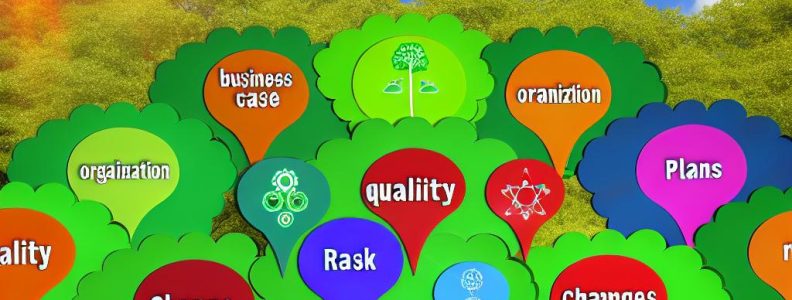The Seven Themes of PRINCE2 and Their Importance
PRINCE2, which stands for PRojects IN Controlled Environments, is a structured project management method widely recognized and used in numerous industries. This methodology originated from the best practices in government projects in the United Kingdom and has evolved to be applied globally. The essence of PRINCE2 lies in its structured yet flexible approach that accommodates various types of projects.
A significant component of PRINCE2 is its seven themes. These themes represent critical aspects of project management that are essential for maintaining the integrity and efficiency of a project. They must be addressed and carefully managed throughout the project’s lifecycle to achieve successful outcomes. Below is an expansion on the importance and application of each theme.
Business Case
The Business Case theme is foundational in PRINCE2. It is central to decision-making and determines whether a project should proceed or halt. This theme mandates that projects are continuously assessed for continued viability against criteria of desirability and achievability. A business case justifies the project’s onset by predicting benefits, costs, risks, and timeframe. As a project progresses, this theme requires updates to reflect new information and adapt to changes in the external environment. It is one of the main communication tools used to align the project with the organization’s strategic objectives. This ensures that the allocation of resources remains justified and that the project continues to deliver value.
Organization
In the Organization theme, the configuration of the project’s structure is outlined, emphasizing the clarity of roles and responsibilities. The success of a project is often linked to how well-defined the roles and responsibilities are, and how effectively they are communicated among all team members and stakeholders. This theme highlights the need for a structured hierarchy within the project, usually based on a project board to make key decisions, and various other roles like project manager and team manager, who ensure project delivery. The participation and commitment of every member involved are crucial, as lack of engagement can lead to inefficiencies and project delays.
Quality
The Quality theme defines the measures required to ensure that the project will deliver products that meet the identified expectations and needs. It is not just about the final product, but also involves continuous quality checks and balances throughout the project lifecycle. This is achieved by setting precise and measurable quality criteria, planning quality assurance processes, and implementing quality control. Through these processes, the project team ensures the deliverables are fit for purpose and meet predefined client specifications. Establishing a culture of quality also contributes to building stakeholder trust, as it demonstrates a commitment to high standards.
Plans
The Plans theme provides a blueprint of how project objectives will be accomplished. Plans are critical as they detail the activities, resources, and timelines involved in a project, serving as a roadmap for execution. They enable project managers to map out future work, assess resource needs, and facilitate effective communication among stakeholders. Importantly, planning is not a one-time activity; it is dynamic and should be revisited and adjusted as the project unfolds. This adaptability allows project managers to effectively respond to uncertainties and unforeseen events, maintain control over project delivery, and ensure alignment with organizational goals.
Risk
A proactive approach to the Risk theme is essential for safeguarding a project against potential threats. Risks can arise from various sources, including technical challenges, resource limitations, and external factors like regulations and market dynamics. This theme involves the identification, assessment, and prioritization of risks, followed by developing strategies to mitigate them. Risk management is about preparing for the unexpected while trying to mitigate adverse impacts on the project’s success. By effectively managing risks, project teams can prevent disruption of project activities and maintain a focus on delivery of objectives.
Change
In PRINCE2, change is a constant reality that must be managed systematically. The Change theme covers the process of evaluating and implementing change requests, examining their potential impact on the project’s objectives and business case. Change can occur due to numerous factors, such as new stakeholder requirements, market changes, or evolving technology standards. This theme ensures that changes are handled with due diligence, considering factors such as cost, time, and project scope. By maintaining robust change control mechanisms, projects can remain agile, yet retain enough stability to fulfill their objectives.
Progress
The Progress theme focuses on monitoring and reporting a project’s progress in relation to the plan, facilitating control mechanisms such as regular reviews and status updates. Effective progress monitoring enables early detection of variances from the plan, allowing corrective actions to be implemented promptly. This theme relies on key performance indicators and milestone tracking to gauge whether a project is on schedule and within budget. Sound management of progress ensures that stakeholders are informed about project status and can make decisions based on accurate data, which supports the project in meeting its intended deliverables.
In conclusion, the seven themes of PRINCE2 offer a comprehensive framework for managing projects effectively within controlled environments. Each theme addresses distinctive elements of project management, contributing to a cohesive and structured approach. Understanding and applying these themes allows project managers to enhance project delivery, achieve strategic alignment, and ultimately ensure stakeholder satisfaction. For those interested in deepening their understanding of PRINCE2, numerous resources, such as guides and courses, are available to aid in further developing project management skills.


